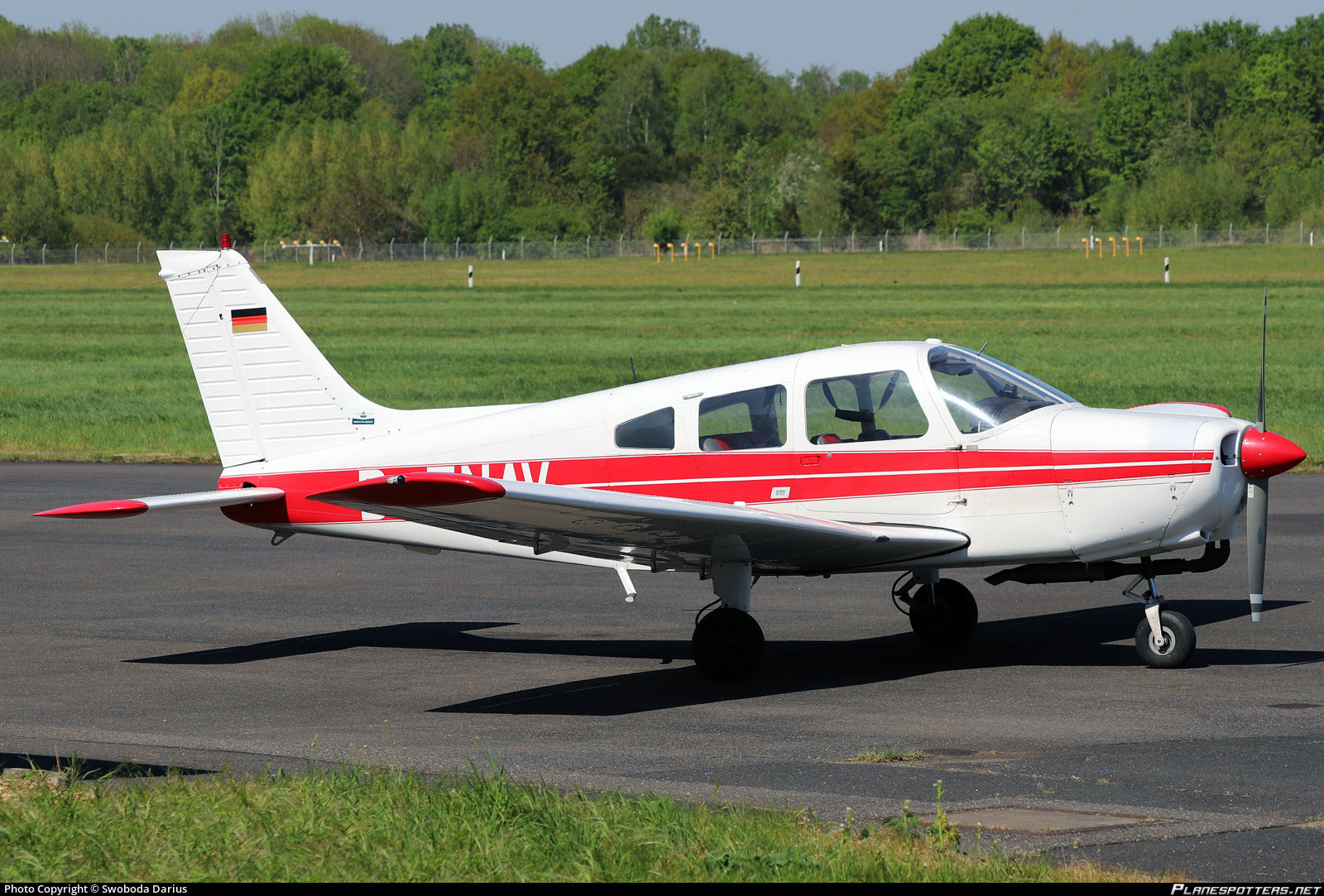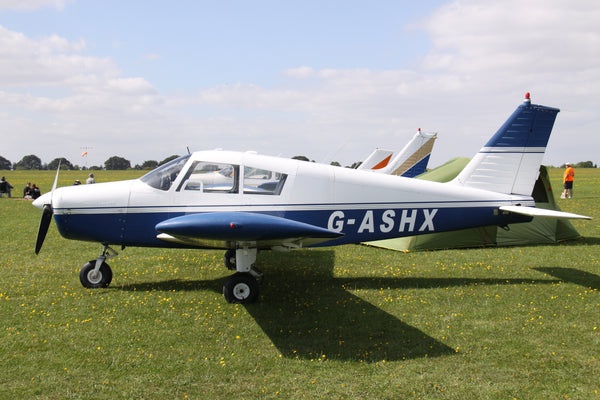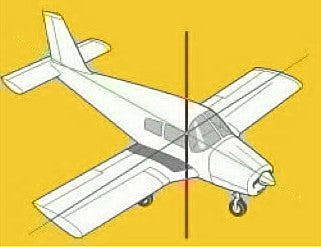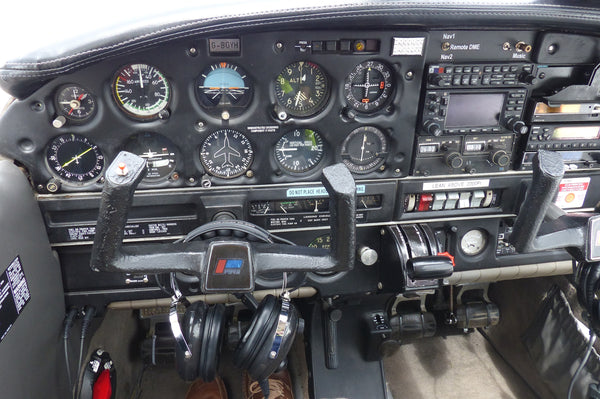
#2 in 100in100: The Piper P28 Series, a Comprehensive Guide
The conceptualization of the Piper PA-28 series, known for its robust design and versatility, was driven by market needs and aviation trends during the late 1950s and early 1960s. The inception of the PA-28 Cherokee marked a significant shift from Piper's traditional fabric-covered, tube-frame airplanes to modern, all-metal designs, reflecting the era's aeronautical innovation spirit. The Cherokee was developed to replace the PA-22 Tri-Pacer and Colt, offering a low-cost, modern alternative to compete with popular models like the Cessna 172, hence broadening Piper's market appeal.

The Cherokee series was designed by a team including notable figures such as Fred Weick, John Thorp, and Karl Bergey, bringing together a wealth of experience in aircraft design. The first Cherokee model was the PA-28-140, equipped with a Lycoming O-320 engine providing 150 horsepower, despite the "140" in its name. This model, known as the Cruiser, was renowned for its simplicity and reliability, appealing to a wide range of pilots.
The PA-28 series was known for its unique features, such as the "Hershey Bar" wing, named for its shape and a nod to its Pennsylvania roots. The series was produced in Vero Beach, Florida, a hub for Piper's manufacturing activities. Over time, the series evolved, introducing various models with different engine capacities and features. For example, the Cherokee 235, also known as the Pathfinder, was the most powerful variant in the PA-28 series, equipped with a 235 horsepower engine.

As the series matured, Piper introduced more complex variants like the Cherokee Arrow with retractable landing gear, improving aerodynamics and performance. The Arrow series included models like the Arrow II and Arrow III, featuring enhancements such as streamlined fuselages and better-equipped cockpits. The PA-28 series also catered to specific market segments with models like the Cherokee Cadet, marketed as a cost-effective training aircraft, and the Cherokee Charger.
Comparing the PA-28 series to its contemporaries, it offered a low-wing alternative with distinct handling characteristics, differentiating itself from high-wing counterparts like the PA-38 Tomahawk or PA-44 Seminole. The versatility and robust performance of the PA-28 series have made it a staple in general aviation, influencing subsequent designs and continuing to serve as a reliable platform for both training and personal flying.
The original design of the Piper PA-28 was marked by several standout elements that catered to its intended uses, primarily for training and personal flying. The design focus was on creating a simple, robust, and reliable aircraft that could serve various roles effectively.
- Low-Wing Monocoque Structure: The PA-28's low-wing, all-metal, monocoque construction was a significant shift from Piper's previous fabric-covered, tube-frame aircraft. This design offered improved visibility for pilots and passengers, easier entry and exit, and a more modern appearance. The low-wing design also provided more stable handling characteristics, making it suitable for training scenarios.
- "Hershey Bar" Wing: One of the most distinctive features of the PA-28 series was its straight, rectangular wing, commonly referred to as the "Hershey Bar" wing due to its shape resembling the famous chocolate bar. This wing design was simple, cost-effective to produce, and contributed to the aircraft's predictable handling and stable flight characteristics, which were essential for flight training.
- Engine and Power Variants: The PA-28 series was equipped with a range of Lycoming engines, providing various horsepower options. The initial model, the PA-28-140 (Cherokee Cruiser), was powered by a 150 horsepower Lycoming O-320 engine. The availability of different powerplants allowed the series to cater to diverse needs, from flight training to personal flying.
- Spacious and Comfortable Cabin: The PA-28 was designed with a spacious and comfortable cabin, accommodating up to four people. This feature made it an attractive option for flight schools and individuals looking for an aircraft that could also be used for personal and business travel.
- Tri-cycle Landing Gear: The stable tricycle landing gear system of the PA-28 contributed to its reputation for reliable ground handling. This feature was particularly beneficial for student pilots, making takeoffs and landings more forgiving and straightforward.
- Adaptable for Various Roles: The original design allowed for adaptations and upgrades, making the PA-28 series versatile for different roles. Over time, Piper introduced variants like the Cherokee Arrow with retractable landing gear and more powerful engines, enhancing the aircraft's performance and expanding its market appeal.
The Piper PA-28's original design successfully blended simplicity, reliability, and versatility, making it a popular choice for flight training and personal aviation, and laying the foundation for the series' enduring presence in the general aviation market.
The production run of the Piper PA-28 series is notable for its longevity and the variety of models produced over the years. The first PA-28 received its type certificate from the FAA in 1960, and impressively, the series remains in production today. The initial models introduced in the early 1960s were the PA-28-150 and PA-28-160 Cherokees, designed to replace Piper's earlier PA-22 TriPacer and Colt models. These early Cherokees were a departure from the high-wing, fabric-covered designs of the PA-22, featuring a modern low-wing and all-metal construction.
A significant point in the production history was in 1964 when Piper introduced the Cherokee 140 (PA-28-140), tailored specifically for training purposes with a simpler, two-seat configuration initially. This model saw a slight modification shortly after its introduction to boost its engine power to 150 horsepower but retained the -140 designation. The PA-28 series saw continuous evolution, introducing various models like the PA-28R-180 Cherokee Arrow in 1967, which featured a constant-speed propeller and retractable landing gear, and the PA-28R-201T Turbo Dakota in 1979, among others.
The production volume saw various changes, with new models being introduced and older ones being phased out based on market demand and advancements in design and technology. For instance, the introduction of the PA-28R-180 Cherokee Arrow led to the discontinuation of the Cherokee 150 and Cherokee 160. Similarly, in 1977, Piper stopped producing the Cruiser (140) and Pathfinder (235) but introduced the Dakota (PA-28-236), showcasing Piper's responsiveness to market needs and technological advancements.
By the end of 2004, over 30,200 fixed undercarriage PA-28 Cherokee series aircraft had been built, encompassing a wide range of models catering to various market segments, from training to personal and commercial use. The PA-28 series has been continually updated, with recent models incorporating modern avionics and engine options to meet current aviation standards and demands.
The Piper PA-28 series has seen extensive evolution throughout its production run, with numerous significant upgrades, modifications, and variants introduced to improve upon the original design. This evolution has focused on enhancing performance, versatility, comfort, and safety, ensuring the series remained competitive and relevant in the general aviation market. Some key points in the evolution of the PA-28 series include:
- Introduction of Complex Variants: One of the major evolutions was the introduction of complex variants like the Cherokee Arrow (PA-28R-180) in 1967. This variant featured a constant-speed propeller, retractable landing gear, and a more powerful engine (180-horsepower Lycoming IO-360-B1E). The Arrow series continued to evolve with the Arrow II, Arrow III, and Arrow IV, introducing improvements such as fuselage stretching for increased legroom, semi-tapered wings for better low-speed handling, larger fuel tanks, and distinctive design elements like the "T" tail on the Arrow IV.
- Engine Upgrades and Performance Improvements: Throughout the production run, various models of the PA-28 series received engine upgrades and performance improvements. For instance, the initial Cherokee 140 model was quickly upgraded to produce 150 horsepower. Later models like the Cherokee Warrior (PA-28-151) were introduced with stretched bodies and new semi-tapered wings, enhancing the aircraft's aerodynamics and flight performance.
- Introduction of Turbocharged and Diesel Models: The PA-28 series also saw the introduction of turbocharged models like the PA-28R-201T Turbo Dakota in 1977, which featured a six-cylinder Continental TSIO-360-F engine equipped with a Rajay turbocharger. Although the Turbo Dakota did not sell well and production ended in 1980, it represented Piper's commitment to exploring high-performance options within the PA-28 series.
- Variety of Models for Different Uses: The PA-28 series offered a variety of models to cater to different market segments. Models like the Cherokee Cadet were marketed as cost-effective training aircraft, while others like the Cherokee Warrior and Cherokee Archer were popular for both training and personal use. The diversity in models allowed buyers to choose an aircraft that matched their specific flying needs, whether it was for private flying, flight training, or commercial use.
- Modern Avionics and Comfort Features: Later models of the PA-28 series incorporated modern avionics suites, including GPS and autopilot systems, significantly enhancing pilot situational awareness and ease of flight. Interior design and comfort features were also improved, ensuring that the series kept pace with the expectations of modern pilots and passengers.
- Structural Innovations: The PA-28 series also featured structural innovations, such as the transition from the original "Hershey Bar" wing to semi-tapered wings in later models, improving flight stability and control. The use of all-metal construction and the introduction of the tricycle landing gear system contributed to the aircraft's robustness and reliability.
The 1968 Piper PA-28, a representative model from the Cherokee series, is known for its reliable performance and versatility.

Here are the detailed specifications:
General Specifications:
- Type: Single-engine, piston aircraft
- Role: Training, personal, and business use
- Crew: 1 (pilot)
- Passengers: Up to 3
Performance:
- Engine: Lycoming O-320 series (four-cylinder, air-cooled)
- Horsepower: Varies by sub-model (150-160 HP for PA-28-150/160)
- Cruise Speed: Approximately 123 knots (141 mph, 227 km/h)
- Stall Speed: 47 knots (54 mph, 87 km/h) with flaps down
- Range: 465-720 nautical miles (535-828 miles, 861-1333 km), depending on model and tank configuration
- Service Ceiling: 10,000-14,000 feet (3,048-4,267 meters), depending on the model
- Rate of Climb: Around 660-900 feet per minute (201-274 meters per minute), depending on the model
Dimensions:
- Wingspan: 30 feet (9.14 meters)
- Length: 23.3 feet (7.1 meters) for the PA-28-140/150/160
- Height: 7.3 feet (2.2 meters)
Weight:
- Empty Weight: Around 1,200 pounds (544 kg), varies slightly by model
- Maximum Takeoff Weight: Approximately 2,150-2,400 pounds (975-1,089 kg), depending on the model
Capacity:
- Fuel Capacity: 25-50 gallons (95-189 liters), depending on tank configuration
- Seating: Four seats (including pilot)
Avionics and Equipment:
- Standard Avionics Package: Basic instruments for VFR (Visual Flight Rules) flying, including an altimeter, airspeed indicator, attitude indicator, turn coordinator, and heading indicator.
- Optional Equipment: Various options over the years including IFR (Instrument Flight Rules) avionics, autopilot, GPS, and upgraded communication/navigation equipment.
When comparing the 1968 Piper PA-28 to other aircraft in its class, like the Cessna 172, it's noteworthy for its low-wing design, offering a different flying experience and ground handling characteristics compared to the high-wing design of the Cessna. The PA-28 series generally offers a variety of engine options and configurations, allowing for a broader range of performance capabilities. Its versatility in seating, fuel capacity, and avionics options makes it a suitable choice for a wide range of pilots, from students to experienced aviators.
Here's a general overview of the performance characteristics, V-speeds, G-load limitations, and approved maneuvers:
Performance Characteristics:
- Cruise Speed: Approximately 123 knots (141 mph, 227 km/h), depending on the model and conditions
- Stall Speed (Vs0): About 47 knots (54 mph, 87 km/h) with flaps down
- Stall Speed (Vs1): Higher than Vs0, varies by model, without flaps
- Maximum Range: 465-720 nautical miles (535-828 miles, 861-1333 km), depending on model and tank configuration
- Service Ceiling: 10,000-14,000 feet (3,048-4,267 meters), model-dependent
- Rate of Climb: Around 660-900 feet per minute (201-274 meters per minute), model-dependent
V-Speeds (typical for the series, but check the specific POH for exact figures):
- Vr (Rotation Speed): Speed at which the nose wheel is lifted off the ground
- Vx (Best Angle of Climb Speed): Provides the highest altitude gain per unit of ground distance
- Vy (Best Rate of Climb Speed): Provides the most altitude gain per unit of time
- Va (Maneuvering Speed): Maximum speed at which full or abrupt control movements can be applied without overstressing the airframe
- Vfe (Maximum Flap Extended Speed): Maximum speed with flaps extended
- Vno (Maximum Structural Cruising Speed): Speed not to be exceeded except in smooth air
- Vne (Never Exceed Speed): Maximum speed under any conditions
G-Load Limitations:
- Normal Category: +3.8/-1.52 Gs (utility category aircraft may have different limitations)
- These limitations are essential for maintaining structural integrity during flight and are especially pertinent during training scenarios where maneuvers and recovery from unusual attitudes are practiced.
Approved Maneuvers:
- The PA-28 is approved for a range of standard flight maneuvers typical for training and personal flying but is not rated for aerobatics. Maneuvers typically include stalls, steep turns, chandelles, and lazy eights.
- Certain versions of the Piper PA-28, particularly those in the utility category, were indeed approved for spins provided certain conditions were met. The utility category is more stringent in terms of structural requirements compared to the normal category, allowing for a wider range of maneuvers, including intentional spins.
- The specific maneuvers approved may vary slightly based on the model and year of manufacture, so it's always best to consult the official Pilot's Operating Handbook (POH) for the exact model you're flying.
The PA-28's performance is well-suited to its roles in training and personal aviation due to its predictable handling characteristics, stable flight behavior, and relatively forgiving stall characteristics. The aircraft's versatility in configurations and its range of V-speeds make it an excellent platform for training scenarios, allowing students to experience and learn various aspects of flight within a safe and controlled environment. For personal aviation, the PA-28's performance provides a good balance between speed, range, and fuel efficiency, making it a practical choice for personal travel and recreational flying.
The safety record of the Piper PA-28 series is generally viewed positively within the aviation community. The series, described as universally easy to fly, has been subject to thorough safety reviews by aviation safety organizations like the AOPA Air Safety Foundation. The Piper PA-28 series, which includes models from the Cherokee 140 to the 235, and the retractable-gear Arrow, has been part of an in-depth analysis to understand the nature of accidents and how they compare to similar aircraft in its category.
The comparison of fixed-gear PA-28s was made with aircraft like the Beech 19, 23, 24; Cessna 172, 182; and the Grumman AA-5. The retractable Arrow was compared against aircraft such as the Beech Sierra; Cessna 172RG, 182RG; the Rockwell Commander 112, 114; and the Mooney M20. The findings indicated that both the fixed-gear Cherokees and the Arrow had slightly lower total-accident rates than their comparable aircraft. However, the Cherokee models did exhibit a higher serious-accident rate. Interestingly, the Arrow model showed nearly 25% more total accidents than the fixed-gear Pipers, speculated to be due to the increased workload from the aircraft's complexity, leading to more pilot distractions and consequently more accidents.
The original acquisition cost of the Piper PA-28 series in the late 1960s is not readily available in the sources I found. However, I was able to locate information on the estimated price for a Piper PA-28-140 Cherokee model from that era, as of June 2022. The estimated price for models from 1965 to 1968 was approximately $52,678.
In the current market, the prices for a 1968 Piper PA-28 can vary significantly based on the condition of the aircraft, total time on the airframe, engine hours, avionics updates, and other factors. For example, a 1968 Piper Cherokee 140/160 was listed at $73,500, showing that well-maintained and updated models can command higher prices. Another listing for a 1967 Piper Cherokee 140/160 showed a price of $115,000, indicating a significant price for a fully restored model. On the other hand, a 1/4 share of a 1967 PA-28-180D was offered at $30,000, demonstrating that shared ownership can be a more affordable option for acquiring a stake in this aircraft.
The Piper PA-28 series stands as a testament to enduring design and adaptability in general aviation. From its inception in the early 1960s to its continued presence in the skies today, the PA-28 has proven its worth in various roles, particularly in flight training and personal aviation. With a variety of models offering a range of performance capabilities, the series caters to a broad spectrum of aviation needs. Its safety record, while reflecting the inherent challenges of aviation, demonstrates a relatively strong standing when compared to its peers, with a significant portion of incidents attributable to pilot error, emphasizing the importance of proper training and adherence to safety protocols. The current market values of these aircraft, although varying based on numerous factors, indicate a lasting demand and appreciation for this iconic series.
Bibliography and Useful Links:
- "Piper PA-28 Cherokee" - Wikipedia. Link
- "The Evolution of the Piper PA-28 Cherokee: From Training Aircraft to High-Performance Variants" - Such Airplanes. Link
- "Plane Facts: Piper PA-28s" - Plane & Pilot Magazine. Link
- "A history of the Cherokee" - General Aviation News. Link
- "Weights and Dimensions for Piper PA-28 Models" - Airliners.net. Link
- "PA-28 Safety Review" - AOPA. Link
- "New ASF review analyzes safety record of Piper Cherokees, Arrows" - AOPA. Link
- "PIPER Cherokee (PA-28-140/150/160/180)" - SKYbrary Aviation Safety. Link
- "PIPER CHEROKEE PA28 SERIES For Sale - Used & New 1 - 24" - Trade-A-Plane. Link
- "BARNSTORMERS.COM Find Aircraft & Aircraft Parts - Airplane Sale, Jets, Helicopters, Experimental, Warbirds & Homebuilt" - Barnstormers. Link
- "1965 - 1968 PIPER PA-28-140 Cherokee - Specifications, Performance, Operating cost, Valuation, Brokers" - PlanePhD. Link
 -Dale Berger has been immersed in aviation for over 40 years. A USAF veteran and private pilot since 1986, he has been Chief Inspector for 3 different avionics shops. He and his wife Kim currently own and operate Essco Aircraft, an aviation publications and pilot supplies business in Barberton Ohio.
-Dale Berger has been immersed in aviation for over 40 years. A USAF veteran and private pilot since 1986, he has been Chief Inspector for 3 different avionics shops. He and his wife Kim currently own and operate Essco Aircraft, an aviation publications and pilot supplies business in Barberton Ohio.
